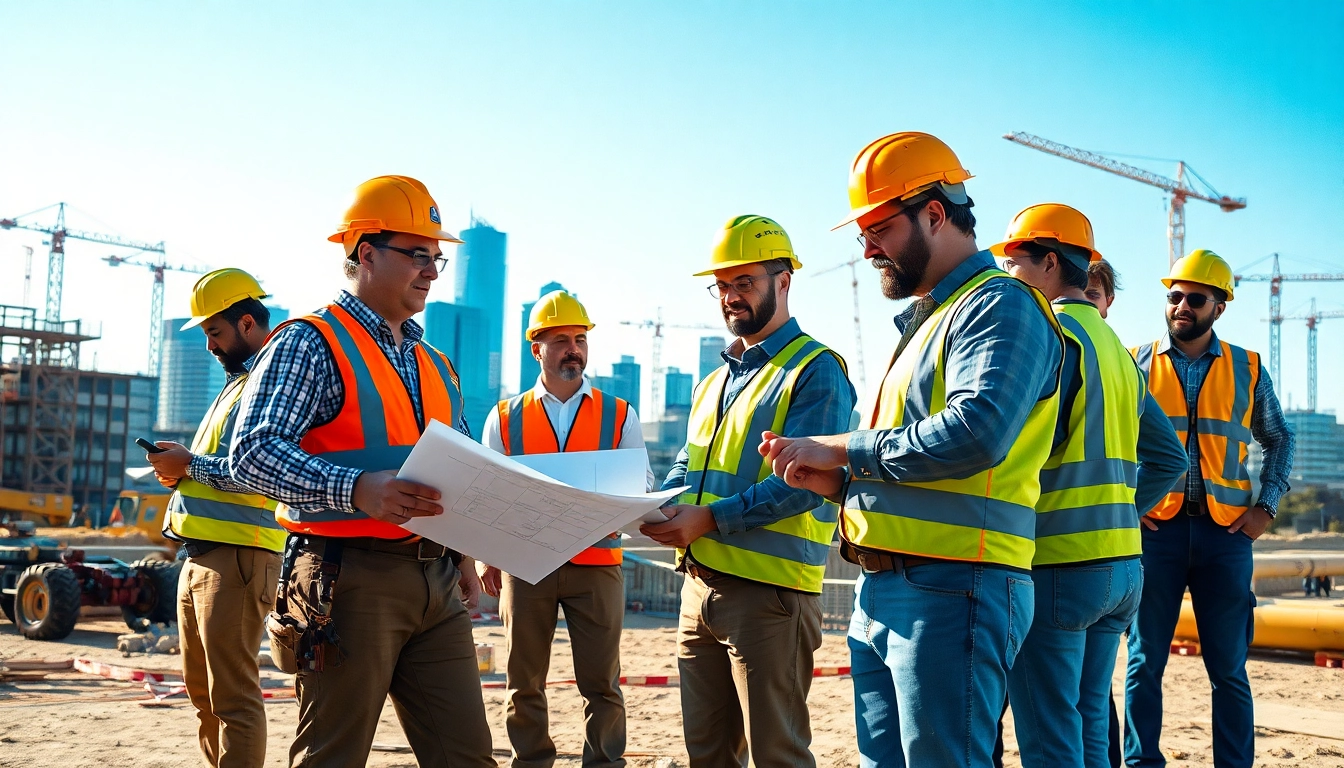
Insights into Austin Construction: Trends, Challenges, and Opportunities
Understanding the Austin Construction Landscape
Austin, Texas, stands as a vibrant hub of growth and development, drawing both residents and businesses with its unique blend of culture, innovation, and opportunity. The austin construction scene reflects this dynamism, encompassing a range of projects from residential buildings to commercial spaces and infrastructure improvements. Understanding the construction landscape here requires a look into its historical context, current trends, and the key players shaping its future.
Historical Overview of Construction in Austin
To truly appreciate the current construction environment in Austin, it is essential to explore its history. The city’s development began in the mid-19th century, when it was founded as the capital of the Republic of Texas. Early construction efforts focused on civic and governmental structures, setting a foundation for growth.
As the 20th century progressed, Austin experienced several transformational changes, particularly with the post-World War II boom that brought an influx of population and industries. This era marked the beginning of large-scale housing developments, commercial projects, and public infrastructure that would forever alter the city’s landscape.
More recently, the tech boom during the 1990s and 2000s catalyzed yet another wave of construction, with many tech companies establishing headquarters and campuses in the area. This led to a new demand for office spaces, housing units, and amenities, driving innovation within the industry.
Current Trends Shaping the Industry
Today, several prominent trends are shaping the Austin construction landscape:
- Urban Infilling: As Austin continues to grow, preserving green spaces while maximizing land use has become crucial. Developers are focusing on infill projects to revitalize underused areas within the city.
- Mixed-Use Developments: There’s an increasing preference for projects that combine residential, commercial, and recreational spaces, promoting walkability and integrated living.
- Smart Construction: The integration of smart technologies in construction processes is gaining traction. Builders are adopting innovative construction techniques, such as modular construction, which offers faster build times and reduced costs.
- Focus on Sustainability: Environmental considerations are influencing construction practices, with a growing emphasis on energy-efficient buildings and sustainable materials.
Key Players in the Austin Construction Sector
The Austin construction sector is characterized by a mix of established firms and emerging startups. Notable players include large construction companies known for significant commercial projects, alongside smaller contractors specializing in residential developments.
Among the prominent construction firms are those such as Hensel Phelps, renowned for their work on various major projects in the Austin skyline, and Turner Construction, which has expanded its presence steadily over the years. Additionally, local architects and design-build firms bring unique perspectives that blend functionality with artistry, playing a vital role in shaping the aesthetic of new developments.
Major Challenges in Austin Construction
Despite its promising growth, the Austin construction industry faces several significant challenges that impact project timelines, costs, and overall success.
Labor Shortages and Workforce Development
One of the most pressing issues facing the construction sector in Austin is a shortage of skilled labor. As projects multiply, the demand for qualified workers often outpaces supply.
This situation has led to increased competition for talent, driving up wages and project costs. Firms are responding by investing in workforce development programs, offering apprenticeships, and collaborating with local educational institutions to cultivate a new generation of skilled workers. These initiatives not only address the immediate labor needs but also ensure a sustainable talent pipeline for the future.
Regulatory Hurdles and Compliance Issues
Navigating the regulatory landscape in Austin can be a daunting task for construction firms. Zoning laws, building codes, and environmental regulations can often present obstacles that delay projects and increase costs.
Compliance requirements vary greatly depending on the type of project and its location, necessitating thorough planning and consultation on the part of developers. To alleviate this burden, many companies are investing in compliance specialists who can streamline the permitting process and reduce the risk of costly delays.
Sustainability and Environmental Concerns
As awareness around climate change and sustainability grows, the construction industry in Austin is under increasing pressure to adopt environmentally friendly practices. From sourcing sustainable materials to implementing energy-efficient technologies, construction firms must consider their environmental impact at every stage of development.
Additionally, community pushback against projects perceived as harmful to the environment poses further challenges. Developers are increasingly encouraged to incorporate green building certifications, such as LEED, into their projects, which not only mitigates environmental impact but can also enhance marketability in an eco-conscious marketplace.
Best Practices for Austin Construction Projects
In the face of challenges, adopting best practices can enhance efficiency, safety, and overall project success in the Austin construction landscape.
Project Management Strategies for Efficiency
Effective project management is key to navigating the complexities of construction projects. Strategies such as Agile project management, which emphasizes flexibility and collaboration, can significantly improve workflow.
Additionally, employing a robust project management software that enables real-time tracking, communication, and resource allocation can streamline processes and help teams to adhere to timelines and budgets.
Safety Standards and Protocols
Worker safety is paramount in construction, making it essential for firms to adhere to strict safety standards and protocols. Regular training, safety audits, and a culture that prioritizes safety can help mitigate workplace accidents.
Utilizing technology, such as wearable devices and safety apps, can further enhance safety measures by providing real-time data and alerts about potential hazards on-site.
Harnessing Technology in Construction
Technology is transforming the construction landscape, offering innovative solutions for project efficiency and quality control. Drones, for instance, facilitate site surveying and monitoring, while Building Information Modeling (BIM) enhances collaboration and planning.
Construction firms in Austin are increasingly aware of the importance of integrating technology into their operations to remain competitive and address the evolving needs of the market.
Case Studies: Successful Austin Construction Projects
Examining successful construction projects in Austin provides valuable insights into best practices, innovative solutions, and the impact of these developments on the community.
Residential Developments Reshaping Neighborhoods
One standout example is the Mueller community, a master-planned development located on the site of the former Austin airport. This project embodies sustainable design principles and features a variety of housing options, parks, and commercial spaces, creating a vibrant community atmosphere.
Mueller’s success has inspired similar projects across the city, showcasing how thoughtful development can positively impact neighborhoods and promote community engagement.
Commercial Projects Driving Economic Growth
The The Domain is a prime example of a commercial hub that has reshaped the business landscape in Austin. This mixed-use development combines shopping, dining, and office space, serving as a magnet for national retailers and tech startups alike.
By attracting businesses and creating jobs, The Domain has significantly contributed to Austin’s economy while enhancing the urban experience for residents and visitors.
Innovative Infrastructure Initiatives
The Austin Central Library project is a notable infrastructure initiative that emphasizes sustainability and community involvement. Completed in 2017, this state-of-the-art facility incorporates green building practices, from rainwater harvesting to energy-efficient design.
The library has become a community hub, offering educational programs, creative spaces, and events that foster engagement, showcasing how innovative infrastructure can enrich local culture and enhance quality of life.
Future Outlook for Austin Construction
The future of construction in Austin is promising, characterized by growth opportunities and evolving trends that are likely to shape the industry landscape.
Predicted Industry Trends and Growth Areas
Forecasters predict that Austin’s construction industry will continue to expand, driven by increasing population growth and demand for diverse housing options. There will likely be a surge in multi-family residential buildings to accommodate the influx of new residents, coupled with continued investment in commercial projects as more businesses seek to establish a presence in this thriving city.
Moreover, the emphasis on sustainability and smart city initiatives will continue to influence project planning, making green construction practices a fundamental expectation rather than an optional feature.
Investment Opportunities in Construction
Investors are increasingly drawn to Austin’s construction sector, recognizing the potential for strong returns in a growing market. Opportunities span various niches, from residential and commercial real estate to innovative technologies that enhance construction processes.
In addition, Public-Private Partnerships (PPP) are becoming a strong avenue for infrastructural development. These collaborations allow for shared risk and investment in major projects that benefit the entire community, paving the way for sustainable growth.
Building a Sustainable Future for Austin
As Austin navigates the complexities of urban development, building a sustainable future remains at the forefront of the construction sector’s agenda. This involves not only integrating eco-friendly practices in construction but also fostering adaptive reuse of existing structures to minimize waste and preserve the city’s historic character.
Engaging community stakeholders in the development process will also be crucial, ensuring that projects reflect the needs and desires of residents while fostering a stronger sense of community. By prioritizing sustainability and inclusivity, Austin can set a roadmap for a resilient and innovative construction landscape that meets the demands of tomorrow.
